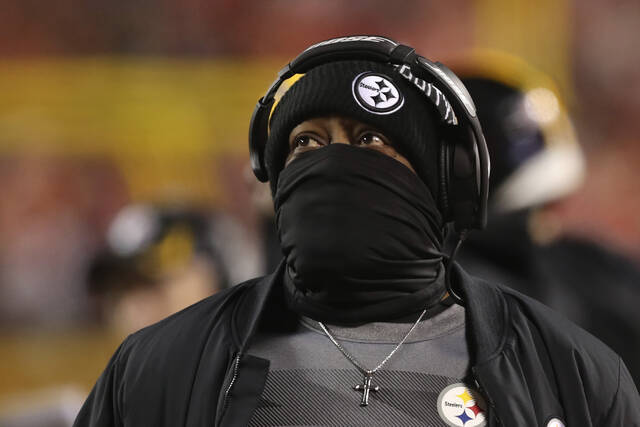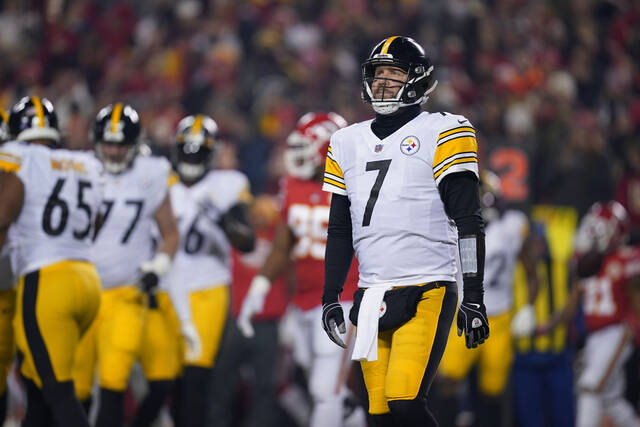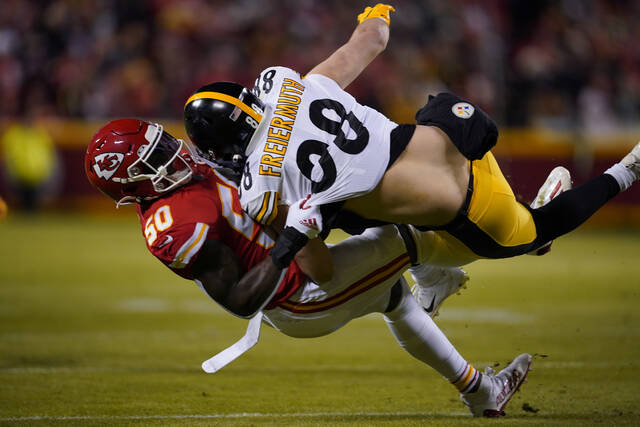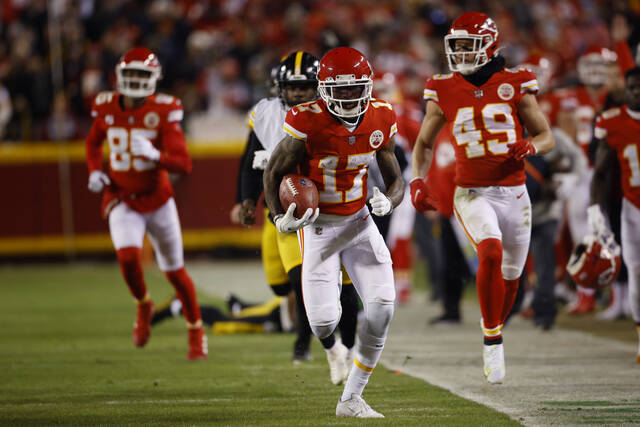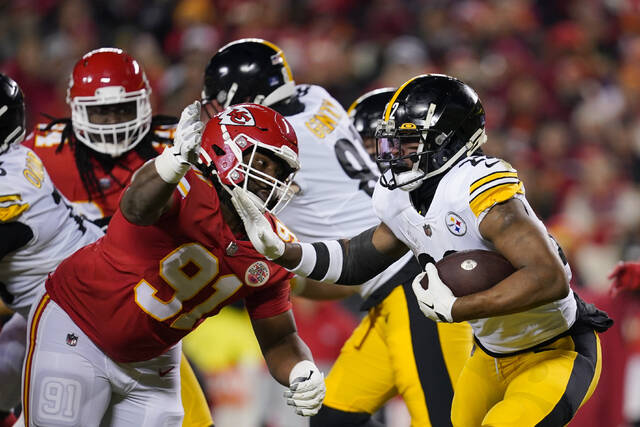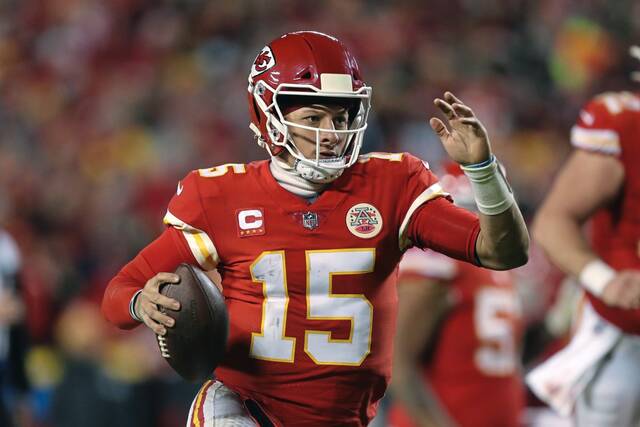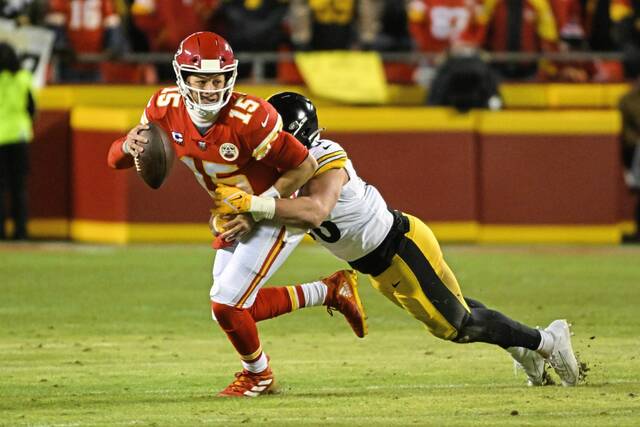Steelers vs. Chiefs wild-card game film study: First-half swing too much to overcome
NFL football analyst Matt Williamson breaks down each of the Steelers games in the Trib’s Steelers Film Study. Here’s what he saw in the Steelers’ wild-card game loss to the Chiefs.
A huge underdog on the road, the Pittsburgh Steelers traveled to Kansas City to take on the red-hot Chiefs Sunday night. While they made it interesting for about 20 minutes, it then quickly became clear Pittsburgh’s season was coming to an end.
By no means was this game just about one position or player, but it sure did show the importance of the quarterback position in the NFL. And, with all respect to Ben Roethlisberger and his outstanding career, this was about as big of a quarterback discrepancy as you will see in one team’s favor in a playoff game.
Telling statistics
• At the half, Pittsburgh was losing 21-7. Kansas City was averaging 7.6 yards per play compared to 1.6 by the Steelers.
• While the Chiefs had only run 13 more plays and possessed the football for about three more minutes, they produced 302 yards against 44 by Pittsburgh’s offense. Still, Kansas City had run five more plays than the Steelers had total yards at halftime.
• But how about this: The Chiefs produced 16 first downs compared to just two by Pittsburgh, which had seven first half possessions and seven first half punts.
• And Kansas City was losing the turnover battle 2-0 at halftime.
But how about the individual halftime achievements?
• Kansas City QB Patrick Mahomes was 19 of 28 for 241 yards.
• Roethlisberger was 5 of 14 for 24 passing yards.
• At that point, KC tight end Travis Kelce had caught just three balls, but for 94 yards and a touchdown.
• As for the running backs, Kansas City’s Jerick McKinnon carried the ball six times for 40 yards but also chipped in with five first-half catches for another 58 receiving yards. At that point, Najee Harris carried the ball 10 times, but for just 27 yards with zero receptions.
• The Steelers had 31 total first-half rushing yards.
• While Pittsburgh did have seven possessions in the first half — and did nothing with them — the Chiefs had the ball on an amazing eight occasions before halftime. Most teams get about 10 or 11 drives for an entire game.
• Pittsburgh generated minus-1 total yard with its first three possessions.
Numbers game
When this game, and the Steelers season, was all said and done, here were the key numbers from this 21-point loss.
• Pittsburgh narrowed the gap in garbage time with some of these numbers, including time of possession, penalties, first downs, and total plays. But the most telling number is probably Kansas City’s 7.4 yards per play against just 3.9 by the Steelers offense.
To give that some context, San Francisco and Tampa Bay led the NFL this year, producing 6.1 yards per play. The Carolina Panthers offense was the worst in the NFL averaging just 4.6 yards every time they snapped the football.
• Mahomes threw for 404 yards on his 39 pass attempts compared to the 215 passing yards Roethlisberger produced on his 44 passes — much of that against prevent defenses.
• McKinnon had 142 total yards compared to 28 from Harris.
• Kelce caught five passes for 108 yards, and six different Chiefs had at least four receptions.
• James Washington led Pittsburgh with 37 receiving yards even though nine different Steelers caught multiple passes.
• Pittsburgh’s defense allowed the Chiefs to convert on eight of 12 third-down tries as well, while the Steelers converted just one of their first eight third-down tries.
• Kansas City’s offense also finished perfect in the red zone and scored touchdowns in embarrassing ways in tight against the Steelers defense.
Scoreless first quarter
Coming into this game, the Steelers had scored a measly 37 first-quarter points in 2021. That was the lowest number in the league. Kansas City had scored 130 first-quarter points, the best in football.
Well, this game was scoreless after the first 15 minutes of play. So that is some progress. However, Pittsburgh produced just 12 first quarter yards…not so great. And the Steelers didn’t score a single touchdown in the first quarter of their last nine games, including this one, and scored just nine total first-quarter points in those nine games. That is really concerning.
Where it went wrong
There were far too many self-inflicted mistakes on both sides of the ball for the Steelers in this game. Their last trip to Kansas City was possibly their worst in this capacity. There were too many communication issues, blown blocking assignments, blown coverages and things of the like once again in Kansas City. The Chiefs are just too strong of an opponent to give them so many breaks.
This game was lost in the “Middle Eight,” the four minutes to end the first half and the four minutes to begin the second half of play. After Kansas City scored a touchdown on its seventh drive in the first half, the Steelers got the ball back with 1 minute, 55 seconds left in the half.
After just an abysmal offensive drive, the Chiefs quickly got the ball back with 52 seconds left with three timeouts. The Chiefs took a 21-7 lead into halftime then quickly made it 28-7 after their opening drive in the second half. The game was essentially over at that point.
Kansas City scored five touchdowns in just a 10:30 stretch of game time, which is remarkable. The Chiefs scored a touchdown on six straight possessions, which is also remarkable.
Quick draw Roethlisberger
Roethlisberger’s 2.08 seconds average time to throw was even less than his league-low average. Actually, it was much less. He had no interest in holding the football for plays to develop or to attack the defense on the intermediate levels. In fact, Roethlisberger completed just one single pass 2.6 seconds after the snap of the ball.
To put that in perspective, quarterbacks such as Aaron Rodgers, Kirk Cousins and Joe Burrow held the ball on average for right around 2.6 seconds this year.
Kansas City’s L’Jarius Sneed also dropped several should-have-been interceptions on plays in which Roethlisberger held the ball for at least 2.6 seconds. He completed only five passes 5 yards or more downfield. His career was magnificent, but it is over.
Drops prove costly
Roethlisberger certainly didn’t get nearly enough support from his receivers though. Simply put, the team needed more from Chase Claypool and Diontae Johnson, especially with the level of quarterback play presented here. Johnson only produced .83 yards per route run, even though he was targeted 10 times.
Drops were obviously a problem once again. JuJu Smith Schuster returned but didn’t really impact the game. He was targeted, on average, 4.4 yards downfield and only created 13 yards after his five catches. But three of Smith-Schuster’s catches did produce first downs. Smith-Schuster out snapped Claypool, 52 to 44, and ran 10 more routes than the second-year receiver.
It would have been nice to see Smith-Schuster and tight end Pat Freiermuth together more this year. Both are physical players who do their best work in the middle of the field, and it wouldn’t be difficult to devise schemes where these two played off one another’s strengths.
Tight end Zach Gentry actually played 42 snaps in this game compared to 31 by Freiermuth and was used out on a route on six more occasions than the rookie.
Washington stands tall
It was only two plays, but receiver James Washington was a bright spot in this game. Roethlisberger threw the ball poorly Sunday night, but his receivers also didn’t help him nearly enough. There were too many drops and not enough contested catches, but Washington did his part and certainly made the most of his limited opportunities after what was mostly a down year for the impending free agent.
Emphasis on running game
The Steelers offense came out dedicated to the run and because of how the game was going, they were able to stick with it throughout much of the first half. Harris was obviously compromised in this game with his elbow injury. But how about this: Harris actually saw negative yards before first contact. He had one run of 5 or more yards. Harris also had minus-1 yards as a receiver and fumbled for the first time in his career.
A guy the anemic Steelers offense leaned on all year couldn’t be leaned on against the Chiefs. Running backs Kalen Ballage and Benny Snell combined to play 38 snaps in this game. Pittsburgh should look to find an upgrade behind Harris and/or a complementary running back with big-play ability this offseason.
Chiefs defenders shine
For Kansas City’s defense, Willie Gay Jr. didn’t have to play a ton of snaps, but he was all over the field and made play after play from the second level of the defense. Nick Bolton, who the Chiefs drafted this past year — a year after selecting Gay — also was a major impact player at linebacker. These two could soon become one of the best linebacker pairings in the NFL.
Defending Mahomes
The Steelers defense held up well early on, but just couldn’t sustain that excellence for close to long enough in Kansas City. This can be lost considering the outcome, but Mahomes struggled early and wasn’t comfortable for about the first third of this game.
As usual, Cameron Heyward and T.J. Watt were the driving force for that early success. The defense was the only reason this game was as close as it was for about the first third of the football game, but the offense and special teams just didn’t do their part, and the defense suffered from too much time on the field against a great opponent and too many short fields to defend.
Heyward’s effort and competitive nature really stood out when this game was well out of reach. He’s a tremendous leader and football player.
Coming into this game, Pittsburgh’s defense was one of the heaviest single high safety units in the NFL, often with safety Minkah Fitzpatrick as the deep middle defender — something Fitzpatrick does extremely well. But almost every defense Kansas City has faced this year has lived out of two-high safety looks to take away the deep ball and explosive plays. Pittsburgh varied its coverages Sunday night, but it really didn’t matter against a dialed in quarterback.
As for Mahomes, he was brilliant and got better as the game went on. Mahomes completed 23 of his 26 attempts for 210 yards and two touchdowns on attempts fewer than 10 yards downfield. He has really matured as a quarterback from earlier in the year and is content to nickel and dime his way down the field when that is what the defense dictates.
He killed the Steelers in the quick game as well as his downfield passing. When Mahomes saw a single-high safety, he attacked downfield. When Pittsburgh was in a two-high look, Mahomes got it out quick in a spot where his receivers could excel after the catch. He is becoming a complete quarterback, which should terrify the rest of the AFC for years to come.
Kansas City’s offensive line gave Mahomes ample room to move around and navigate the pocket and his legs, and mobility to extend plays was just more than the Steelers could handle. That being said, Pittsburgh’s edge rushers certainly got the better of the Chiefs offensive tackles, but getting Mahomes on the ground was easier said than done. Creed Humphrey paved the way for Kansas City’s ground game and got consistent movement up the middle of the Steelers defense all night. The overall offensive team speed Kansas City presents gave the tired Steelers defense fits more and more as the game went on.
Secondary situation
The Steelers cornerbacks were occasionally put in one-on-one situations and somewhat predictably, allowed too many big plays on the perimeter. Joe Haden and Cameron Sutton were the biggest culprits. But you can also question why they were put in these compromised positions against guys like Tyreek Hill.
What might be lost after the fact is that, once again, Ahkello Witherspoon played a strong game. Witherspoon could be the Steelers first in-house free agent to prioritize this offseason, probably at the expense of the 32-year-old Haden’s future in Pittsburgh.
Chiefs put skill on display
It certainly wasn’t just Kelce and Hill in this game doing damage although those two did catch 10 passes for 165 yards and two touchdowns. Kelce produced a whopping 3 full yards per route run, a huge number for a tight end. Kelce also produced 67 yards after the catch. Oh, and he threw a touchdown.
For the second consecutive game, receiver Byron Pringle hurt the Steelers, scoring two touchdowns, as he did in Week 16. Mecole Hardman, known as a deep threat because of his great speed, was used mostly underneath. Hardman’s average depth of target was just 0.2 yards downfield, but he produced 48 yards after the catch while breaking tackles and running away from Pittsburgh’s defenders.
Running back Jerick McKinnon came into this game with fresh legs and just destroyed the Steelers defense. As has been the case for months now, the Steelers provided huge holes for the opposing running back to run through. But McKinnon also showed off his explosive traits and ripped off some chunk runs.
McKinnon’s impact as a receiver was even more felt, as he produced 108 yards after the catch. He played 51 of a possible 65 snaps for the Chiefs while Darrell Williams mostly operated as the third-down back.
Tackling struggles continue
Pittsburgh’s tackling was also quite suspect and, once again, few positives came from the second level defenders. At inside linebacker, Robert Spillane played 34 snaps and Devin Bush played 33. Joe Schobert played barely more, seeing the field for 35 plays. Schobert was probably the best of the bunch.
Spillane’s lack of athleticism really showed up in this game against the speed Kansas City presents. This is a position that must be addressed, and Schobert looks like an obvious salary cap casualty.
Chief concerns
Two things that makes Kansas City’s offense so hard to play against — and we saw this in a big way on Sunday — is its screen game and five-man route concepts. Andy Reid’s teams are always elite in the screen game and throw a wide variety of screens at their opponents.
And Kansas City’s improved offensive line now better allows them to get all eligible receivers out in routes. Both areas were extremely difficult for the Steelers to deal with, as they are for all defenses.
Punter progresses
It might seem like a small thing, but punter Pressley Harvin rebounded well in the final game of his rookie season, averaging 49.7 yards on his seven punts. He punted well in this game in far from perfect weather, but Pittsburgh’s coverage units certainly could have been better.
It was also a little surprising that the Steelers didn’t try to steal a possession on special teams early in this game with a fake punt, surprise onside kick or something along those lines.
Final thoughts
Some things Steelers fans need to remember: While the organization would never admit it, this was Pittsburgh’s version of a rebuilding year. Only the Lions and Jets played more rookie snaps in 2021 than the Steelers.
Outside of Roethlisberger, this is a young team of guys under contract for next year, and the Steelers have a lot of salary cap space.
This was all by design and leads to what should be the most exciting (and crucial) offseason we can remember for this franchise.
With all that considered, was this a successful season? Yes. Is there a lot to address though? Absolutely.
Remove the ads from your TribLIVE reading experience but still support the journalists who create the content with TribLIVE Ad-Free.





